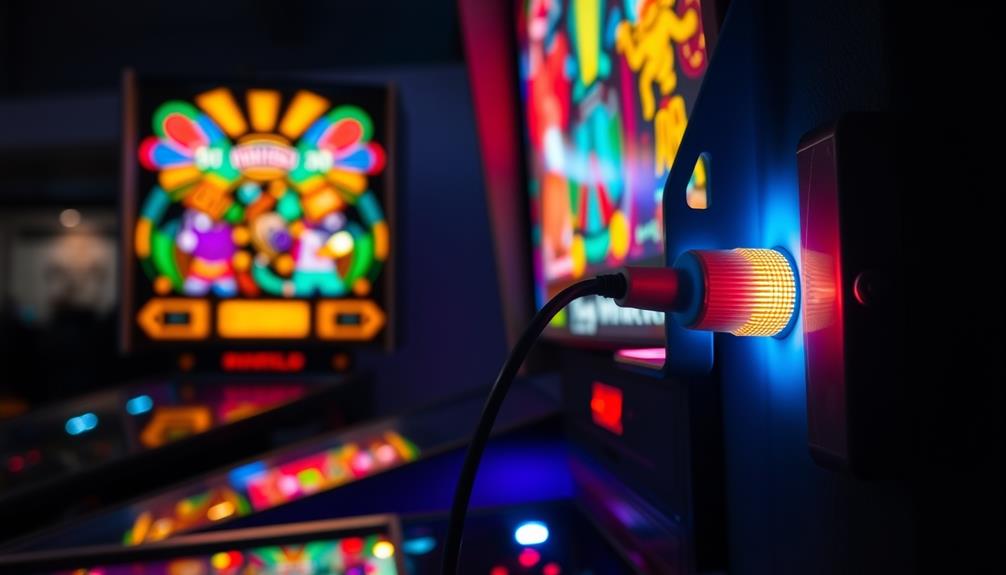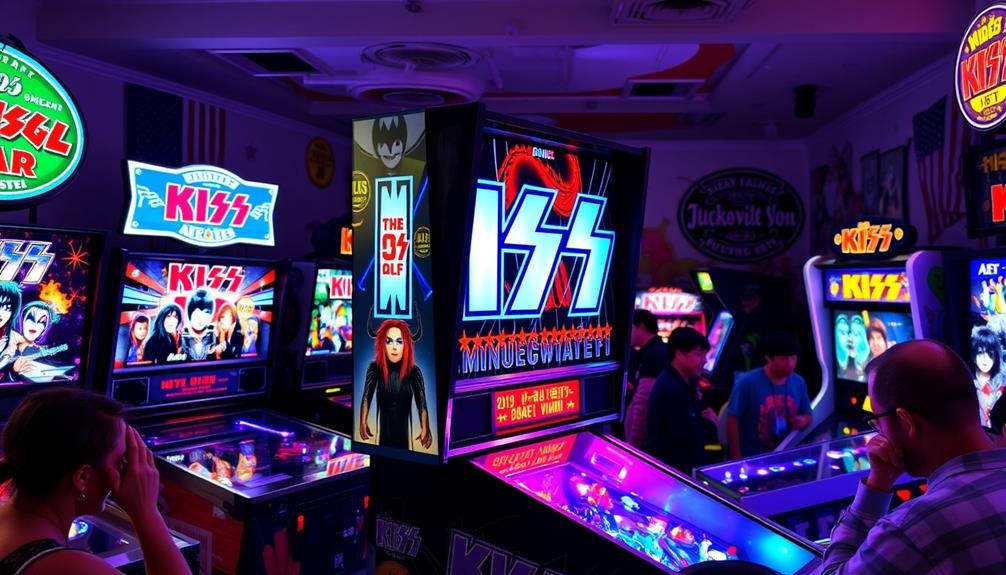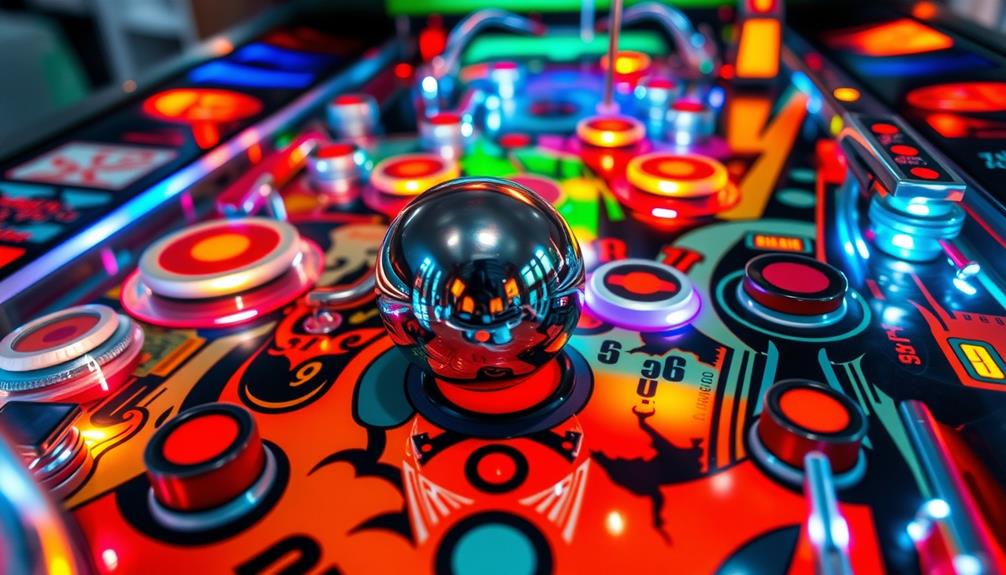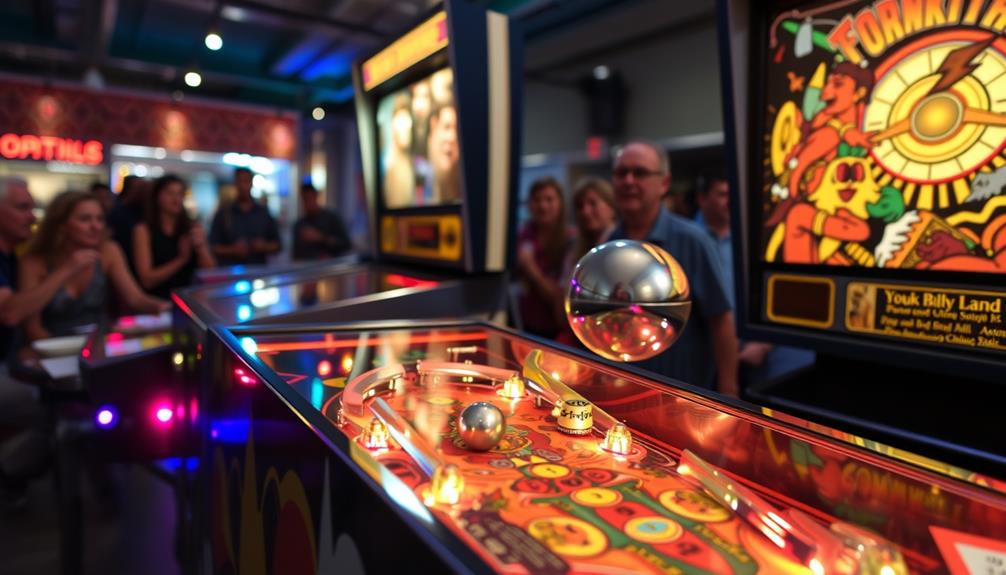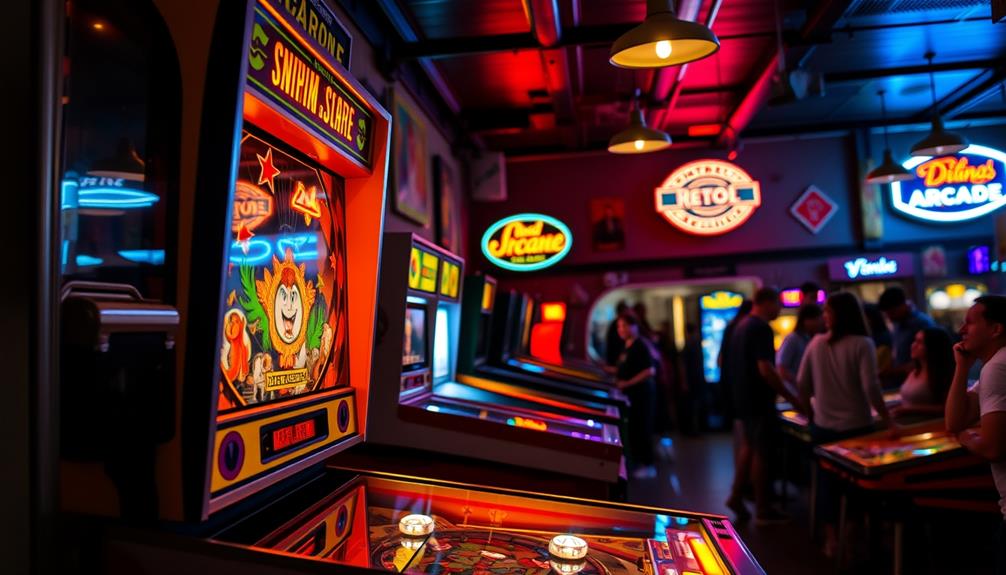A pinball machine usually consumes between 245 and 350 watts while being played. Most machines typically use around 300 watts, which is equivalent to approximately 2.5 amps at 120 volts. However, if you own a high-demand model, it may reach up to 480 watts, especially when all features are activated. Even when idle, pinball machines with full LED lighting can consume about 100 watts. Understanding these power needs can assist in effectively managing energy expenses. Keep exploring to discover more about how various features and lighting choices can impact a pinball machine’s power usage. When contemplating buying a pinball machine, it’s crucial to consider the ongoing energy costs associated with its operation. Additionally, the price of used pinball machines can vary based on the model, age, and condition. Researching and comparing the used pinball machines’ prices is essential to ensure you are receiving the most value for your investment, taking into account both the initial cost and the long-term operating costs.
Key Takeaways
- Pinball machines typically consume between 245 and 350 watts during active play, averaging around 300 watts.
- High-demand models can peak at 5 to 6 amps, reaching approximately 480 watts.
- Idle power consumption for fully LED-equipped machines is about 100 watts.
- The type of bulbs used significantly impacts power draw, with LEDs being more efficient than incandescent bulbs.
- Continuous operation at 300 watts costs about $0.576 daily at an average rate of $0.08 per kWh.
Power Consumption Overview
When it comes to power consumption, pinball machines can pack quite a punch. Typically, a pinball machine consumes between 245 and 350 watts per hour during active play. This means that when you're having a great time flipping those flippers, your machine is drawing around 2.5 amps at 120 volts, which translates to approximately 300 watts of power consumption.
Understanding the importance of budgeting your energy costs can help you make informed decisions about your gaming setup.
However, it's crucial to note that some high-demand models can peak at 5 to 6 amps, pushing power usage estimates to around 480 watts or more during intense gameplay.
Even when you're not actively playing, these machines don't completely shut off. Fully LED-equipped pinball machines can still consume around 100 watts in idle mode, which highlights the importance of monitoring idle power use.
If you run a pinball machine continuously at 300 watts for 24 hours, you can expect an average daily cost of about $0.576, assuming an electricity rate of $0.08 per kWh.
Factors Affecting Power Usage
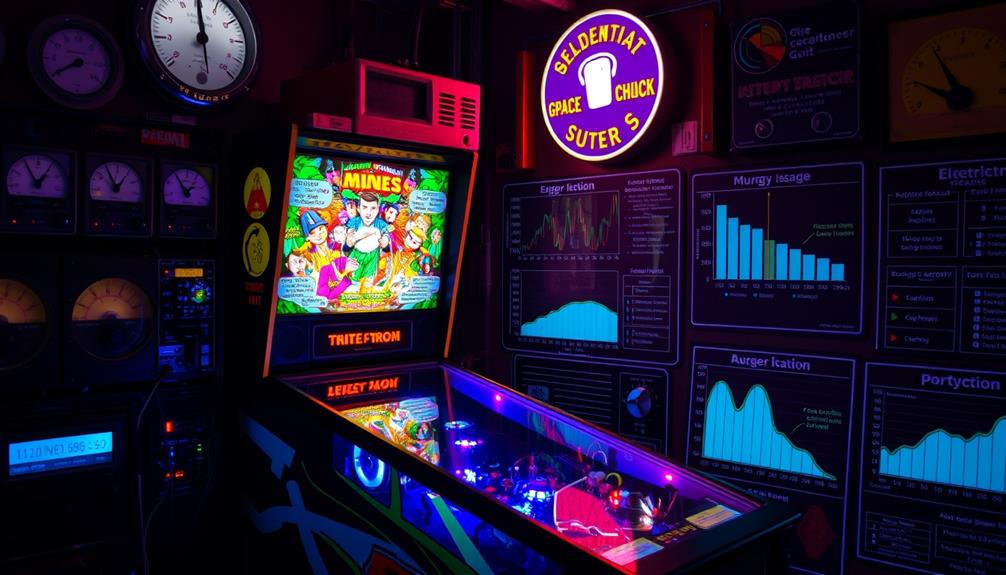
Factors affecting power usage in pinball machines can vary greatly based on several key elements. The type of lighting you choose plays a substantial role; machines with incandescent bulbs can consume up to 600 watts during gameplay, while those equipped with LEDs typically use around 245 to 350 watts. This difference highlights how bulb type directly impacts overall power consumption.
Additionally, consider how using essential oils for toothache relief can enhance your overall health while playing, as certain oils may alleviate discomfort during long gaming sessions.
Additionally, the complexity of the mechanical components and the specific electronics used in the game can also influence power usage. During active play, the average current draw ranges between 2.1 to 2.5 amps, correlating to approximately 240 to 300 watts at a standard voltage of 120 volts.
Don't forget about idle power consumption, either. Even when not in use, some pinball machines can draw around 100 watts if fully equipped with LEDs. This means that your choice of machine and its features can greatly affect your total energy use.
LED vs. Incandescent Bulbs

Choosing between LED and incandescent bulbs for your pinball machine can considerably impact power consumption and overall performance. Incandescent bulbs typically draw around 300 watts during gameplay, while switching to LED bulbs can reduce that by about 25%. This significant drop in power usage translates into lower electricity costs over time.
Here's a quick comparison to highlight the difference:
| Bulb Type | Power Consumption (Watts) |
|---|---|
| Incandescent Bulb | 6 watts |
| LED Bulb | 0.1 – 0.2 watts |
When you replace 50 incandescent bulbs with LEDs, you'll save approximately 270 watts. Even though the initial investment for a full LED conversion ranges from $170 to $220, the longevity and reduced heat generation of LEDs make them a smart choice. You'll recoup costs through decreased maintenance and operating expenses.
Just keep in mind that not all LED options are created equal; some may match or even exceed the power draw of incandescent bulbs. Careful selection is essential to avoid issues like ghosting in your pinball machine's lighting.
Electrical Load Management
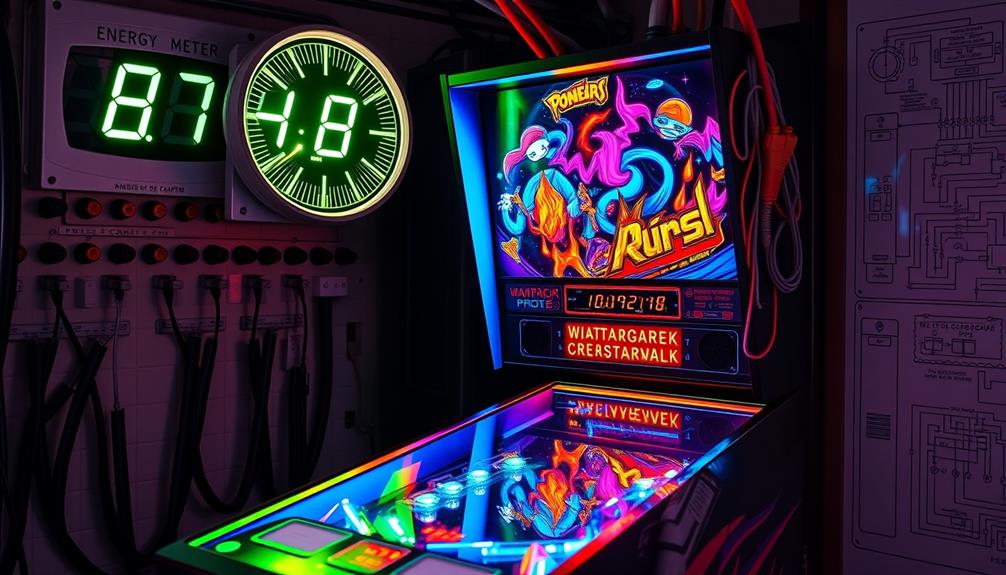
When managing electrical loads for your pinball machines, you need to evaluate circuit capacity carefully.
For peak performance, it's wise to also assess the power consumption of your machines, similar to understanding the best vacuums for dust removal regarding their efficiency.
Balancing the load across your machines is vital to prevent tripping breakers during peak usage.
Circuit Capacity Considerations
Managing circuit capacity is essential for ensuring your pinball machines operate safely and efficiently. Each machine typically consumes between 245 to 350 watts during gameplay, with peak power consumption hitting up to 600 watts based on features and lighting.
To avoid tripping breakers, it's recommended you run a maximum of three pinball machines on a 15A circuit, while a 20A circuit can support up to six machines without issue. Understanding toilet maintenance and repairs can also help in managing your household's overall energy consumption.
During gameplay, the average current draw for most machines is about 2.5 amps at 120V, translating to roughly 300 watts of power consumption. Even when idle, these machines can still draw around 100 watts, impacting your overall energy costs.
That's why proper circuit management is vital. Exceeding the recommended number of machines on a circuit can lead to electrical overloads, creating potential safety hazards.
Load Balancing Techniques
Balancing the electrical load is vital for maintaining smooth operations of your pinball machines. To do this effectively, you should operate no more than three machines on a standard 15A circuit. If you're using a 20A circuit, you may run up to six machines, but it's wise to manage that number carefully. During peak demand, consider running one less machine than the allowed total to guarantee safety.
Understanding how different factors, like astrological signs and perceived beauty, can influence personal confidence may also help you create a more engaging environment for your players.
Using a power meter, like a Kill-A-Watt meter, helps you monitor the actual power draw of your machines. This monitoring is essential for understanding load patterns and adjusting your operations accordingly.
Pinball machines typically have an average power consumption ranging from 245 to 350 watts, which means you need to keep an eye on their peak power demands. These demands can reach up to 5-6 amps per machine. When setting up multiple pinball machines, it’s important to calculate the total power consumption to ensure that it doesn’t exceed the capacity of the electrical circuit or outlet. Additionally, some modern pinball machines have energy-saving features that can help reduce overall power consumption. It’s important to consider these features when determining the overall impact of pinball machine power consumption on your electrical system.
Breaker Trip Prevention Strategies
To prevent frustrating breaker trips, it's vital to monitor your pinball machine setup closely. Start by operating one less machine than the maximum allowed on your circuit—typically three on a 15A breaker and four on a 20A breaker.
Since pinball machines draw between 245 to 350 watts during normal operation, and may peak at 600 watts, careful load management is essential. Incorporating principles of effective strategies for weight loss can also apply here, as sustainable practices in managing electrical load can enhance your gaming experience.
Use tools like a Kill-a-Watt to continuously track your machines' power consumption. This way, you can identify actual usage and avoid exceeding the circuit's capacity.
When connecting multiple machines, pay attention to their total current draw, which can fluctuate, ensuring that the combined load stays within the breaker's rating to prevent overload and breaker trips.
Additionally, consider upgrading to LED lighting in your pinball machines. This change can considerably reduce power consumption, allowing you to operate more machines on the same circuit without the risk of tripping breakers.
Regional Cost Variations
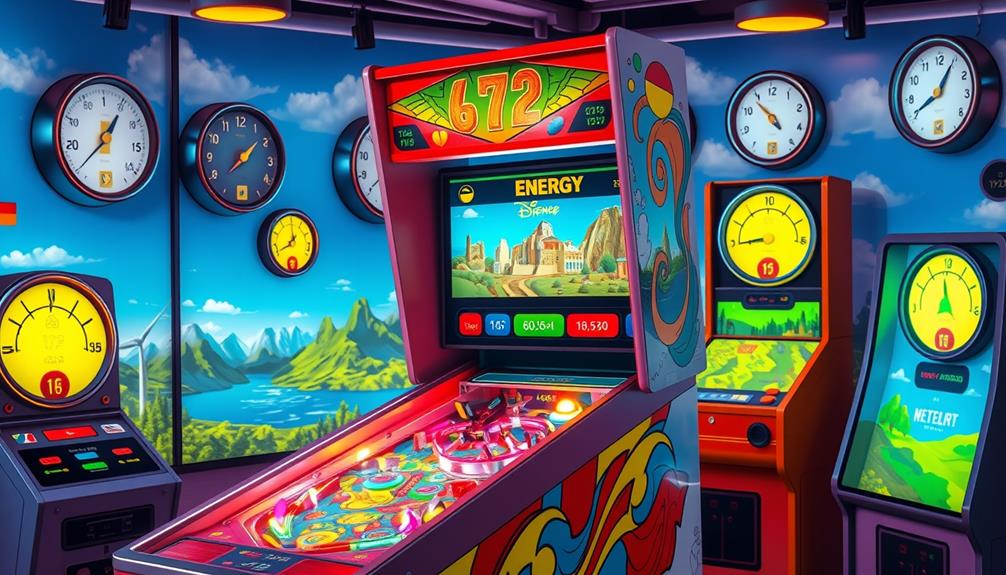
When you're managing a pinball machine, it's vital to understand how electricity rates differ by region.
For instance, rates can be as low as 6.3 cents per kWh in some areas or soar past 20 cents in others, directly affecting your operating costs.
Additionally, considering the potential side effects and interactions of running multiple machines can further influence your expenses.
Being aware of these variations helps you plan your expenses and optimize your machine's profitability.
Electricity Rate Differences
Electricity rates can feel like a hidden variable for pinball machine owners, as they vary widely across different regions. Understanding these rates is essential for managing operational expenses effectively, especially when considering top-rated payment solutions for non-profits that can help streamline your financial operations.
Here's a quick look at how different areas stack up:
- Southwest Missouri: Around 7 cents per kilowatt-hour (KwH)
- Philadelphia: Ranges from 12 to 20 cents per KwH
- Texas: Post-privatization rates as low as 10.7 cents per KwH in Houston
- Las Vegas: Fluctuates between 9.5 cents and nearly 15 cents per KwH
- Average Estimate: About 8 cents per KwH, considered low compared to higher regional averages
These electricity rates greatly impact your budgeting decisions.
If you're in an area with higher rates, you'll likely see a noticeable increase in your operational expenses. Being aware of local utility rates means you can strategize accordingly, ensuring your pinball machine remains profitable.
Always keep an eye on these rates, as they can change and affect your bottom line in unexpected ways!
Impact on Operating Costs**
Regional cost variations can greatly affect the operating expenses of your pinball machine. The average power consumption of these machines ranges from 245 to 350 watts, but how much you pay depends considerably on local electricity rates. Additionally, as AI Cybersecurity Jobs grow in demand, the need for secure payment systems for operating machines may also influence overall costs.
For instance, in Philadelphia, rates can vary from 12 to 20 cents per kilowatt-hour, which means your operating costs might fluctuate widely based on your location.
Let's break it down: if you run a 300-watt machine continuously for 24 hours at a rate of $0.08 per kilowatt-hour, your daily cost would be about $0.576. However, in Houston, where rates soar to around $0.135 per kilowatt-hour, that same machine could cost you approximately $0.972 per day. This stark difference highlights the importance of understanding your local rates.
To manage your operating costs effectively, keep an eye on utility rates and factor in your machine's actual power consumption. Regularly recalculating your expenses based on these variables can help you stay on top of your budget and maximize your pinball machine's profitability.
Benefits of LED Conversion
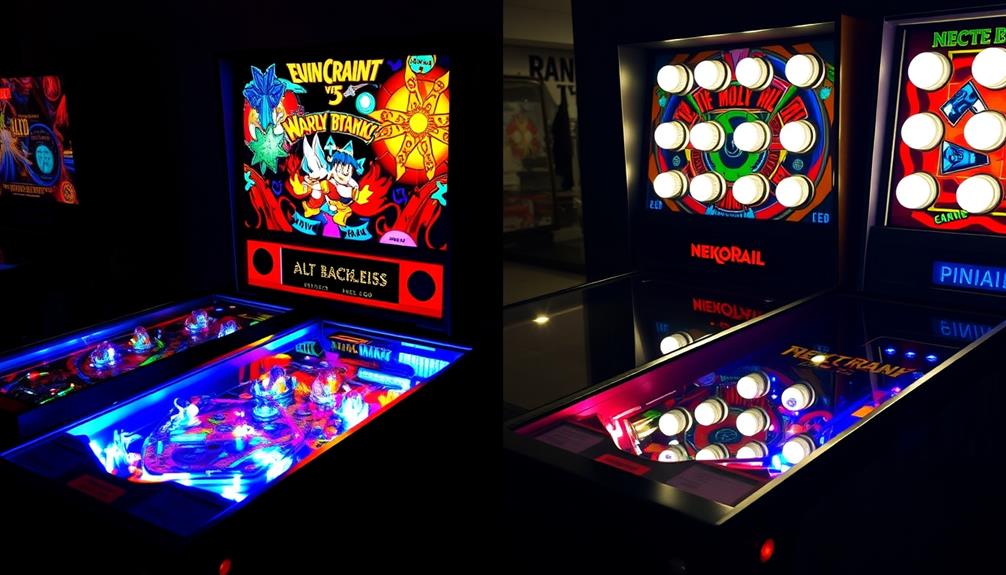
Many pinball enthusiasts are discovering the remarkable benefits of converting their machines to LED lighting. The switch not only enhances the overall experience but also offers considerable advantages regarding efficiency and longevity.
By focusing on content relevance and authority, players can guarantee their machines are optimized for both performance and enjoyment. Here are some key benefits you can expect:
- Reduced Power Consumption: LEDs use only 0.1 to 0.2 watts per bulb compared to 6 watts for incandescent bulbs, leading to approximately 25% less energy usage.
- Energy Savings: By saving around 270 watts when switching to LEDs, your electricity bills will see a noticeable decrease.
- Longer Lifespan: LEDs outlast traditional bulbs, providing a payback period of just 2 to 3 years on your initial investment of $170 to $220.
- Less Heat Generation: With considerably lower heat output, LEDs help protect your machine's playfield and components from potential damage.
- Enhanced Visual Appeal: LED lighting improves the vibrancy and sharpness of your pinball machine's visuals, making gameplay more enjoyable.
Frequently Asked Questions
How Much Power Do Pinball Machines Use?
When considering power usage, you'll find that pinball machines typically draw between 100 to 350 watts, depending on their lighting and gameplay activity. Using a power monitor can help you measure their actual consumption accurately.
How Many Watts Does a Game System Use?
A typical game system usually consumes between 60 to 250 watts, depending on the model and usage. You can save energy by turning it off when not in use, helping reduce your electricity bill.
What Are the Specs of a Pinball Machine?
Power-packed pinball machines feature vibrant visuals, intricate mechanics, and lively lights. They typically weigh around 200-300 pounds, stand about 5-6 feet tall, and boast various themes, adding excitement to your gaming experience.
What Is the Voltage of a Pinball Machine?
Pinball machines typically operate on 120 volts in North America. If you have an international model, it might require 230 volts. Knowing the voltage helps you manage your electrical setup effectively and safely.
Conclusion
In the grand scheme of fun, pinball machines can be surprisingly easy on your power bill, especially if you opt for LED bulbs. By understanding the ins and outs of their power consumption, you can enjoy those classic games without worrying too much about your electric meter spinning wildly. So, go ahead and indulge in a little nostalgia—your wallet will thank you, and you might even save a few watts while you're at it!
